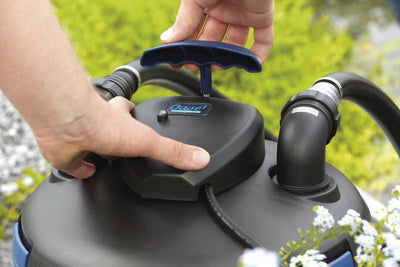 Are you tired of being dragged around every time you take your furry friend for a walk? Does your dog's pulling habits make your leisurely strolls feel more like a workout session? Well, it's time to take control and master the art of leash walking! In this comprehensive guide, we will equip you with all the tools and techniques you need to transform your dog's pulling habits into a thing of the past. From understanding the root causes of pulling to implementing effective training strategies, and of course -using the right walking gear, we've got you covered.
Are you tired of being dragged around every time you take your furry friend for a walk? Does your dog's pulling habits make your leisurely strolls feel more like a workout session? Well, it's time to take control and master the art of leash walking! In this comprehensive guide, we will equip you with all the tools and techniques you need to transform your dog's pulling habits into a thing of the past. From understanding the root causes of pulling to implementing effective training strategies, and of course -using the right walking gear, we've got you covered.
Get ready to enjoy peaceful and enjoyable walks with your four-legged companion while strengthening your bond along the way. So, say goodbye to the frustration and hello to mastering walking your dog on the lead. Let's dive in and unleash the secrets to a well-behaved and obedient walking partner!
The importance of leadwalking for dogs
Walking your dog on the lead is an essential skill for all dogs to learn. Not only does it provide them with much-needed exercise and mental stimulation, but it also ensures their safety and the safety of others. When dogs are properly trained to walk on a leash, they can be taken for walks in public places, allowing them to explore their surroundings and socialize with other dogs and humans. Leash walking also helps establish boundaries and reinforces your position as the pack leader, which is crucial for a well-behaved and obedient dog.
However, lead walking goes beyond just physical exercise. It is an opportunity for you and your dog to bond and spend quality time together. Walking side by side, with your dog calmly by your side, creates a sense of unity and trust. It allows you to communicate and understand each other better, strengthening the bond between you and your furry companion.
Walking your dog is not only beneficial for your dog's physical and mental well-being but also for your own. It provides you with an opportunity to get outside, breathe in some fresh air, and enjoy the beauty of nature. It's a chance to relax, unwind, and clear your mind while spending quality time with your beloved pet. So, don't underestimate the importance of lead walking for both you and your furry friend.
Understanding why dogs pull on the lead
 One of the most common challenges dog owners face during lead walking is their dog's tendency to pull. But why do dogs pull on the lead in the first place? Understanding the root causes behind this behaviour is crucial for effectively addressing and correcting it.
One of the most common challenges dog owners face during lead walking is their dog's tendency to pull. But why do dogs pull on the lead in the first place? Understanding the root causes behind this behaviour is crucial for effectively addressing and correcting it.
One of the main reasons dogs pull on the lead is due to their natural instincts. Dogs are curious creatures, and when they're outside, they're constantly bombarded with exciting sights, sounds, and smells. This curiosity and desire to explore can lead to pulling as they try to reach whatever has caught their attention. Additionally, some dogs have a high prey drive, which means they may pull towards small animals or moving objects.
Another common reason for pulling is lack of proper training and reinforcement. If a dog has never been taught how to walk on a lead or has not received consistent training and reinforcement, they may resort to pulling as a way to control their own movements or get to where they want to go. In some cases, dogs may have been inadvertently reinforced for pulling, such as when they are allowed to reach something they were pulling towards.
Lastly, fear and anxiety can also contribute to pulling on the lead. Dogs that are fearful or anxious may try to escape or avoid situations that make them uncomfortable, leading to pulling behavior. It's important to identify and address any underlying fear or anxiety issues to help your dog feel more comfortable and confident during walks.
Understanding why your dog pulls on the lead is the first step towards addressing and correcting this behaviour. By recognising the root causes, you can tailor your training approach and implement techniques that will effectively discourage pulling and encourage calm and controlled lead walking.
The negative effects of pulling on the lead
Pulling on the lead may seem like a minor inconvenience, but it can have several negative effects on both you and your dog. Firstly, it can be physically exhausting for the owner. Continuously being pulled and tugged can strain your muscles and joints, making walks a painful experience rather than an enjoyable one. It can also lead to an increased risk of injury, especially if your dog is large or strong.
Furthermore, pulling on the lead can put your dog's safety at risk. When dogs pull, they are more likely to lunge or dart towards something that catches their attention, increasing the chances of accidents or injuries. This can include running into traffic, approaching aggressive dogs, or getting tangled in objects or obstacles.
Pulling on the lead can also lead to behavioural issues. Dogs that are constantly pulling may become frustrated, anxious, or aggressive, which can manifest in other areas of their life, including interactions with other dogs or humans. Additionally, the lack of control and discipline during lead walks can result in disobedience and a breakdown in communication between you and your dog.
It's important to address and correct pulling habits early on to avoid these negative effects. By implementing effective training techniques and using the right tools, you can transform your dog's pulling habits into calm and controlled walking, ensuring the safety and well-being of both you and your furry friend.
Training techniques for lead walking
Now that we understand the importance of lead walking, the reasons behind pulling on the lead, and the negative effects it can have, let's delve into the training techniques that will help you master the art of walking your dog on a lead. These techniques are designed to encourage calm and controlled walking while strengthening your bond with your dog.
Choosing the right lead and collar
 Before we jump into the training techniques, it's crucial to choose the right lead and collar for your dog. The lead should be sturdy and comfortable to hold, with an appropriate length for your dog's size and walking style. A retractable lead may not be suitable for leash training, as it doesn't provide the necessary control and can encourage pulling.
Before we jump into the training techniques, it's crucial to choose the right lead and collar for your dog. The lead should be sturdy and comfortable to hold, with an appropriate length for your dog's size and walking style. A retractable lead may not be suitable for leash training, as it doesn't provide the necessary control and can encourage pulling.
When it comes to collars, there are several options to consider. A traditional flat collar can work for many dogs, but if your dog tends to pull or has a thick neck, a harness may be a better choice. Harnesses distribute the pulling force more evenly across the body, reducing strain on the neck and providing better control.
Starting lead training with your dog
 The first step in lead training is to introduce your dog to the concept of walking on a lead. Start in a quiet and familiar environment, such as your backyard or a low-distraction area. Attach the lead to your dog's collar or harness and let them explore while keeping the lead loose. This will allow them to get used to the sensation of wearing a lead and having it attached to them.
The first step in lead training is to introduce your dog to the concept of walking on a lead. Start in a quiet and familiar environment, such as your backyard or a low-distraction area. Attach the lead to your dog's collar or harness and let them explore while keeping the lead loose. This will allow them to get used to the sensation of wearing a lead and having it attached to them.
Try the EzyDog Traffic Control lead, it is designed for situations like this! If your dog starts to pull, stop walking and wait for them to return to your side before continuing. This teaches them that pulling will not get them to their desired destination.
Once your dog is comfortable with the lead, it's time to start teaching them to walk beside you. Use positive reinforcement techniques, such as treats or praise, to reward your dog for staying close to your side. Start with short walks, gradually increasing the distance as your dog becomes more comfortable and responsive to your cues.
Common challenges during lead training and how to overcome them!
 During lead training, you may encounter various challenges that can make the process frustrating or overwhelming. Understanding these challenges and knowing how to overcome them will help you stay patient and consistent in your training efforts.
During lead training, you may encounter various challenges that can make the process frustrating or overwhelming. Understanding these challenges and knowing how to overcome them will help you stay patient and consistent in your training efforts.
One common challenge is pulling towards distractions. Dogs are naturally curious, and when they see something interesting, they may pull towards it. To overcome this challenge, teach your dog the "leave it" command and practice it consistently during walks. Reward your dog for ignoring distractions and focusing on you instead. Always have a treat pouch or walkie bag attached to your belt or lead to reward you dog immediately.
Another challenge is leash reactivity, where your dog becomes overly excited or aggressive towards other dogs or humans while on a leash. This behavior can stem from fear, anxiety, or a lack of socialisation. To address leash reactivity, it's important to work on desensitisation and counter-conditioning techniques, gradually exposing your dog to triggering stimuli while rewarding calm and relaxed behaviour.
Additionally, some dogs may exhibit a "stop and plant" behaviour, refusing to move or pulling in the opposite direction. This can be frustrating, but forcing your dog to move can create more resistance and stress. Instead, use positive reinforcement to encourage your dog to move forward, rewarding small steps in the right direction.
Remember, consistency, patience, and positive reinforcement are key when overcoming these challenges. Celebrate small victories and be understanding of your dog's individual needs and limitations.
Positive reinforcement methods for lead walking
Positive reinforcement is a highly effective training technique for lead walking. It involves rewarding your dog for desired behaviors, such as walking calmly by your side or paying attention to you. By associating these behaviours with positive rewards, such as treats, praise, or playtime, you can encourage your dog to repeat them.
involves rewarding your dog for desired behaviors, such as walking calmly by your side or paying attention to you. By associating these behaviours with positive rewards, such as treats, praise, or playtime, you can encourage your dog to repeat them.
When using positive reinforcement, timing is crucial. Reward your dog immediately after they exhibit the desired behaviour, so they can make the connection between the behavior and the reward. Be consistent with your rewards and gradually decrease their frequency as your dog becomes more reliable in their lead walking skills.
Advanced techniques for mastering lead walking
Once your dog has mastered the basics of lead walking, you can move on to more advanced techniques to further refine their skills. These techniques focus on increasing your dog's self-control and ability to handle distractions, ultimately leading to a more enjoyable and peaceful walking experience.
One advanced technique is the "heel" command, where your dog walks calmly beside you with their head at your knee or hip level. This requires a high level of focus and self-control from your dog and can be achieved through consistent training and reinforcement.
Another advanced technique is the "stop and sit" command, which teaches your dog to stop and sit on command during walks. This is particularly useful when approaching road crossings or when you need to regain control in a potentially dangerous situation. Practice this command in a safe and controlled environment before incorporating it into your regular walks.
Troubleshooting common lead walking problems
Even with proper training and reinforcement, you may still encounter some common problems during leash walking. Here are a few troubleshooting tips to help you overcome these issues:
- If your dog pulls on the lead, stop walking and wait for them to calm down. Only resume walking when the leash is loose and your dog is relaxed.
- If your dog lunges at other dogs or humans, create more distance between them and the trigger. Use positive reinforcement to reward calm behavior and gradually decrease the distance over time.
- If your dog becomes overly excited or distracted during walks, incorporate more mental stimulation into their routine. This can include obedience training exercises, puzzle toys, or scent games to help them focus and expend energy.
Remember, consistency and patience are key when troubleshooting leash walking problems. Stay consistent with your training techniques and adapt them to suit your dog's individual needs and challenges.
Resources for further lead walking education
Walking on a lead is a lifelong skill that requires ongoing education and practice. If you're looking to further your knowledge and improve your leash walking skills, there are several resources available to help you.
Books and online courses specifically dedicated to leash walking and dog training can provide valuable insights and guidance. Look for reputable authors and trainers who specialise in positive reinforcement methods and have a proven track record of success.
Local dog training classes or obedience schools can also be a great resource. These classes provide structured training environments and expert guidance, allowing you to learn and practice leash walking techniques under the supervision of experienced trainers.
Lastly, online communities and forums dedicated to dog training and lead walking can offer support, advice, and success stories from fellow dog owners. Engage with these communities to share your own experiences, ask questions, and learn from others who have faced similar challenges.
Mastering the art of walking your dog on the lead is a journey that requires patience, consistency, and a deep understanding of your dog's individual needs and behaviours. By implementing the right training techniques, choosing the appropriate tools, and troubleshooting common problems, you can transform your dog's pulling habits into calm and controlled leash walking.
Remember, walking your dog on the lead is not just about physical exercise; it's an opportunity to bond with your furry friend, strengthen your relationship, and enjoy the great outdoors together. So, say goodbye to the frustration of being dragged around and hello to peaceful and enjoyable walks with your well-behaved and obedient walking partner. With the knowledge and techniques shared in this guide, you're well on your way to becoming a master of walking your dog on the lead!
© weknowpets 2023





